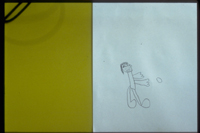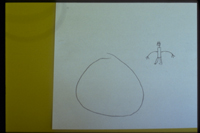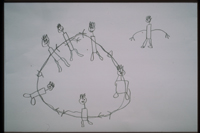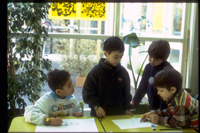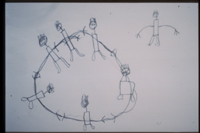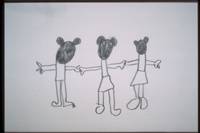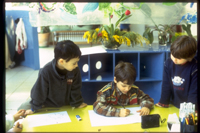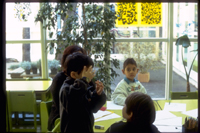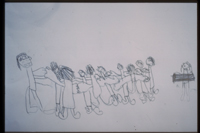At this point, we suggest that the children make a second individual graphic representation of the Ring-Around-The-Rosie, and place them in mixed-gender groups of four to six children. The groups are proposed based on the interpretations the teachers made during the first Ring-Around-The-Rosie experience. We continue our focus on Giulia, Leonardo, and Giovanni.
Documentation Examples > Examples of documentation that is shared more widely
Ring-Around-The-Rosie
School: Municipality of Reggio Emilia
2. Second Drawing
Giulia seems to be the most perplexed: I'm going to do the kid from the back because you need...
She gets up from the table and holds out her arms to look like the figure she has drawn, thinking and expressing her thoughts aloud.
Okay... I have to draw some kids who are standing like I am right now. I made this girl with her back turned... (she holds her arms out in front of her). But what about the others, how do I get them to look like they're standing up? I don't know how to draw the kids from this side.
Giovanni: Giulia, you have to draw the profile...
He shows Giulia the first figure he has drawn. The strategic position of the figure is worth noting: the arms are stretched out in front, ready to link up with another figure seen from a front view and one seen from behind. The figure shown in profile is a structural peg of Giovanni's Ring-Around-The-Rosie.
This is the profile. Giulia, it's better to draw the profile first because otherwise you keep going on and on and then you can't tell what's going on any more! This may be what happened to him in his first drawing (the Ring-Around-The-Rosie in a line).
Leonardo: I know how you draw a Ring-Around-The-Rosie of kids. First you draw a circle, like a Ring-Around-The-Rosie... then you need a kid who's standing outside and looking at it...
Leonardo's initial schema that we saw earlier is still very strong and seems not to have been undermined by the real-life trials of the Ring-around-the-Rosie or by his classmate's comments. Or, if it has been undermined, since a graphic model is a conceptual schema, it will need time to be modeled. At times we may notice that the schema we are using is not appropriate, but we do not know how to modify it.
Giovanni: Hey Leonardo, you can only see your kids from the front! Because the ones you see it from the back are always there, always!
Leonardo: Okay, then I'll put some hair on this one, this one, and this one.
Leonardo takes a pencil and covers up the faces of the figures in the foreground.
In this second Ring-Around-The-Rosie all the children have chosen to use pencils, a choice that probably shows an awareness of the difficulties involved and therefore of the possibility of modifying the drawing. Error and modification are integral parts of research and learning. It is necessary to accept them as such intelligently and without worrying about them.
Leonardo: This is okay because... look: this kid is looking at this one, then this one's looking at this one, this one's looking at this one... there, it's done!
Then, as a final comment on his drawing, he adds: You can see these kids from above, like this. He stands up and raises a hand, almost as if he were defining a point of view from as high as possible: ...and, from the top they look like they're lying on the ground!
In interpreting and commenting on his drawing, Leonardo uses two interpretive readings that were made earlier by Giovanni: one child who, in the relational space of the Ring-Around-The-Rosie, is looking at the face of another child; and the point of view from above.
Here we can see quite clearly how, during the process of learning, continuous loans of knowledge, hypotheses, and points of view are being made among the children.
This drawing by Giulia shows three figures seen from behind. Giulia is still a prisoner of her dilemma. She has understood that it is necessary to draw the children's backs, a conviction that has been strengthened by the dialogue taking place in the meantime between Giovanni and Leonardo. As a result of this, she has added two more girls, who can be seen from behind, but she is still not satisfied.
Turning to Giovanni, Giulia says: How did you do the ones on the other side (the children facing the front)?
Giovanni (pointing at Giulia' s three figures seen from the back one by one): Giulia, I have an idea! Who are these kids looking at? Who's this one looking at? You have to put in the ones on the other side, otherwise they're not looking at anything.
Giovanni: Just look at this, we're doing a real Ring-Around-The-Rosie. Guys, come here, let's do a Ring-Around-The-Rosy! Okay, I'm looking at Giorgio for a while, then Leonardo for a while, Giorgio's looking at Leonardo, Leonardo's looking at Giorgio, then we go around, and for you who are looking at us, everything changes.
Leonardo: Now, Giulia, I'll explain the profile to you... look at me! See? It's like a little line that goes all the way down, like this.
Finally reassured, Giulia then draws two figures from a side view, but the problem persists: Yes, but now where am I going to put the other heads? Can I draw some more faces?
Giovanni: You can see a little bit of the front... not all of it, but you can see it... there's a little bit of room here in the middle to put in the kids who are looking at these ones!
Giovanni: Look at my drawing!
After a few more hesitations, and casting a sidelong glance at Giovanni's drawing on the table every now and then, Giulia completes her drawing.
The rotation of the figure seems to have been understood, though perhaps not the representation of space yet, since the foreground and background figures appear to be compressed almost on a single baseline.



